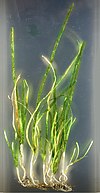Lottia alveus
| Lottia alveus | |
|---|---|
| Scientific classification | |
| Domain: | Eukaryota |
| Kingdom: | Animalia |
| Phylum: | Mollusca |
| Class: | Gastropoda |
| Subclass: | Patellogastropoda |
| Family: | Lottiidae |
| Genus: | Lottia |
| Species: | †L. alveus
|
| Binomial name | |
| †Lottia alveus (Conrad, 1831)
| |
| Synonyms[5] | |
Lottia alveus, the eelgrass limpet or bowl limpet, was a species of sea snail or small limpet, a marine gastropod mollusk in the family Lottiidae, the Lottia limpets, a genus of true limpets. This species lived in the western Atlantic Ocean.
The eelgrass limpet now appears to be totally extinct, but up until the late 1920s, this species was apparently quite common, and was easy to find at low tide in eelgrass beds, in many sheltered localities on the northeastern seaboard of North America.
Distribution before extinction
[edit]This limpet was found from Labrador, Canada, as far south as New York.
It may have become extinct as much as 60 years before its extinction was noticed. (Fall, 2005)
Habitat
[edit]This small limpet used to live on the blades of Zostera marina, a species of seagrass.
Cause of extinction
[edit]
The extinction of Lottia alveus does not seem to have been caused directly by human interference. This small limpet disappeared from the fauna because of a sudden catastrophic collapse of the populations of the eelgrass plant, Zostera marina, which was its sole habitat and food source. In the early 1930s, the seagrass beds all along that part of the coastline were decimated by "wasting disease", which was caused by a slime mold of the genus Labyrinthula.[6][7][8] Some colonies of Zostera marina lived in brackish water, and these areas served as refugia for the eelgrass since the wasting disease did not spread to brackish water. The eelgrass was thus able to survive the catastrophic impact of the disease. The limpet however was unable to tolerate anything but normal salinity seawater, and therefore it did not live through the crisis.[8]
References
[edit]- ^ COSEWIC. 2005. Canadian Species at Risk. Committee on the Status of Endangered Wildlife in Canada. 64 pp., page 6.
- ^ Bouchet, P. (1996). "Lottia alveus". IUCN Red List of Threatened Species. 1996: e.T12382A3339013. doi:10.2305/IUCN.UK.1996.RLTS.T12382A3339013.en. Retrieved 19 November 2021.
- ^ Conrad, T.A. (1831). "Description of fifteen new species of Recent and three fossil shells, chiefly from the coast of the United States". Journal of the Academy of Natural Sciences of Philadelphia. 6: 256–268.
- ^ Dall, W.H. (1921). "Summary of the marine shellbearing mollusks of the northwest coast of America, from San Diego, California, to the Polar Sea, mostly contained in the collection of the United States National Museum, with illustrations of hitherto unfigure species". Bulletin of the United States National Museum. 112 (i–iii): 1–217.
- ^ Rosenberg, G. "Lottia alveus (Conrad, 1831)". Malacolog Version 4.1.1 A Database of Western Atlantic Marine Mollusca. The Academy of Natural Sciences, Philadelphia. Retrieved 5 May 2015.
- ^ Short, F.T.; Muehlstein, L.K.; Porter, D. (1987). "Eelgrass wasting disease: cause and recurrence of a marine epidemic". Biological Bulletin. 173 (3): 557–562. doi:10.2307/1541701. JSTOR 1541701. PMID 29320228. S2CID 42042358.
- ^ Short, F.T.; Ibelings, B.W.; den Hartog, C. (1988). "Comparison of a current eelgrass disease to the wasting disease of the 1930s". Aquatic Botany. 30 (4): 295–304. Bibcode:1988AqBot..30..295S. doi:10.1016/0304-3770(88)90062-9.
- ^ a b Carlton, J.; Vermeij, G.J.; Lindberg, D.R.; Carlton, D.A.; Dudley, E.C. (1991). "The first historical extinction of a marine invertebrate in an ocean basin: the demise of the eelgrass limpet Lottia alveus". Biological Bulletin. 180 (1): 72–80. doi:10.2307/1542430. JSTOR 1542430. PMID 29303643.
External links
[edit]- https://web.archive.org/web/20070510162140/http://biology.mcgill.ca/undergra/c465a/biodiver/2000/eelgrass-limpet/eelgrass-limpet.htm
- The First Historical Extinction of a Marine Invertebrate in an Ocean Basin: The Demise of the Eelgrass Limpet Lottia alveus
- http://www.sararegistry.gc.ca/species/speciesDetails_e.cfm?sid=175
Text is available under the CC BY-SA 4.0 license; additional terms may apply.
Images, videos and audio are available under their respective licenses.

